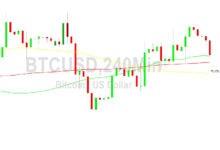Bitcoin Volatility Falls to Two-Year Low as TradFi Markets Wobble

Despite its reputation as an unpredictable and risky asset class, crypto hasn’t been especially volatile in recent weeks.
According to crypto market data provider Kaiko, Bitcoin’s 20-day volatility has come to equal that of the NASDAQ for the first time in two years. But while Bitcoin’s price has remained roughly the same since the start of September, both the NASDAQ and S&P have fallen 13% and 10% respectively since that time.
Historically, Bitcoin has been tightly correlated with tech stocks, but with higher beta (volatility relative to the rest of the market)—thus defying its label in some circles as a safe-haven asset, or “digital gold.” However, despite a violent crash in June, crypto has proven to be one of the best-performing asset classes in Q3, next to the U.S. dollar.
This is either a massive support or breakdown level for #Bitcoin relative to the Nasdaq-100 $NDX: pic.twitter.com/OAUEVrVRFi
— Caleb Franzen (@CalebFranzen) October 17, 2022
As with its volatility, Bitcoin’s actual price descended to late 2020 lows last week after the core U.S. Consumer Price Index or CPI (which excludes food and energy) reached another 40-year high. Bitcoin and stocks both fell on the news, but quickly bounced back into their respective ranges.
Bitcoin’s Correlation With S&P 500 Reaches 17-Month High
June’s initial collapse followed the release of May’s CPI data, which revealed inflation at 8.6%. Markets took it as a sign that the Fed wouldn’t be ending its aggressive policy stance any time soon, inspiring participants to withdraw from “riskier” assets.
That said, although inflation has remained elevated by rough equal measure, crypto hasn’t seen much significant price action with subsequent CPI updates. Stocks, by contrast, continue to trickle downwards.
Meanwhile, the hawkish stances of central banks worldwide are beginning to turn bonds into a volatile-yet-rewarding asset class. As Bloomberg reported last month, bond yields have been skyrocketing thanks to Fed policy, while DeFi yields have fallen to under 100 basis points on protocols like Aave.
Last week, popular Twitter analyst Will Clemente noted how Treasury market volatility has skyrocketed against Bitcoin volatility over the past few months. At the time, equity volatility was also reaching all-time highs against Bitcoin volatility.
The chart Wall St. doesn’t want you to see: Treasury market volatility versus Bitcoin volatility
…but I thought «Bitcoin is too volatile» pic.twitter.com/nX2nDu4ve6
— Will Clemente (@WClementeIII) October 11, 2022
“This illustrates just how much volatility compression Bitcoin is currently experiencing,” he tweeted the following day.
With assets worldwide showing weakness next to the dollar, even the United Nations has called on the Fed to quit raising rates. But the central bank shows no signs of stopping right now.






 Bitcoin
Bitcoin  Ethereum
Ethereum  Tether
Tether  USDC
USDC  TRON
TRON  Dogecoin
Dogecoin  Cardano
Cardano  Bitcoin Cash
Bitcoin Cash  Chainlink
Chainlink  LEO Token
LEO Token  Stellar
Stellar  Monero
Monero  Zcash
Zcash  Litecoin
Litecoin  Hedera
Hedera  Dai
Dai  Cronos
Cronos  OKB
OKB  Tether Gold
Tether Gold  Ethereum Classic
Ethereum Classic  KuCoin
KuCoin  Gate
Gate  Algorand
Algorand  Cosmos Hub
Cosmos Hub  VeChain
VeChain  Dash
Dash  Tezos
Tezos  Stacks
Stacks  TrueUSD
TrueUSD  IOTA
IOTA  Basic Attention
Basic Attention  Decred
Decred  Theta Network
Theta Network  NEO
NEO  Synthetix
Synthetix  Qtum
Qtum  Ravencoin
Ravencoin  0x Protocol
0x Protocol  DigiByte
DigiByte  Zilliqa
Zilliqa  Nano
Nano  Siacoin
Siacoin  Numeraire
Numeraire  Waves
Waves  Ontology
Ontology  Enjin Coin
Enjin Coin  Status
Status  BUSD
BUSD  Hive
Hive  Pax Dollar
Pax Dollar  Lisk
Lisk  Steem
Steem  Huobi
Huobi  OMG Network
OMG Network  NEM
NEM  Augur
Augur  Bitcoin Gold
Bitcoin Gold  Bitcoin Diamond
Bitcoin Diamond  Ren
Ren